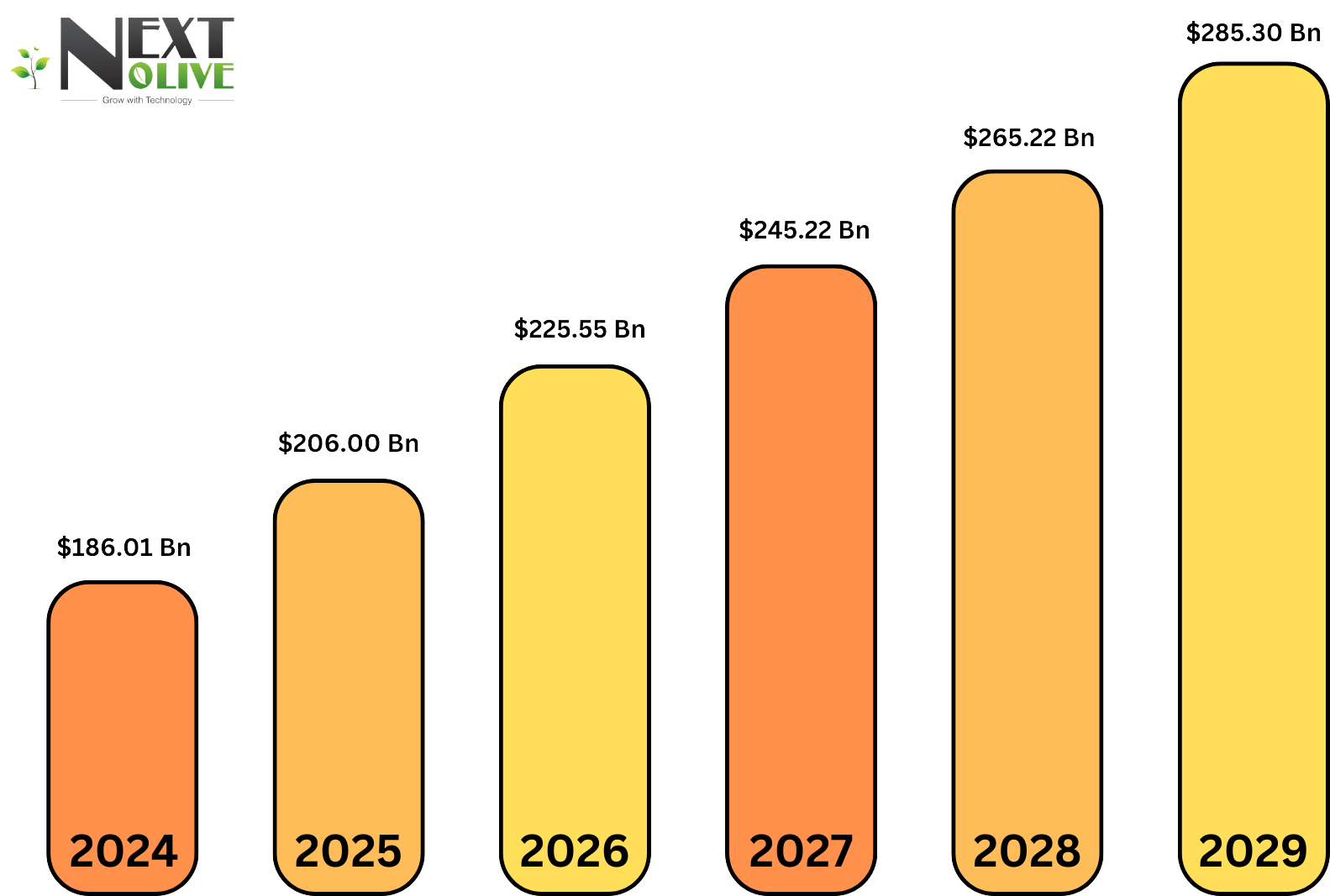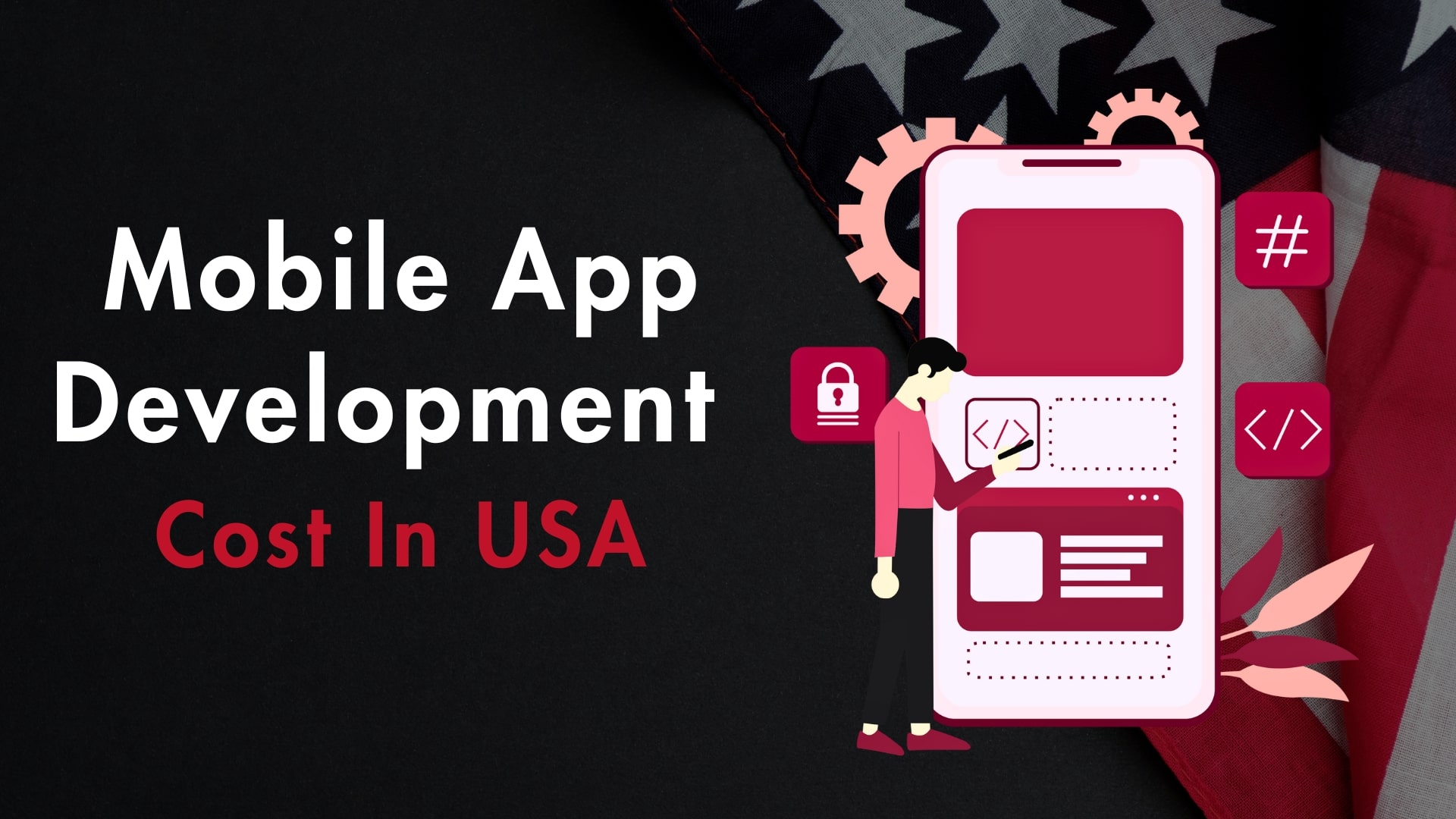How Much Does It Cost to Develop a Mobile App in USA?
Developing a mobile application in the United States is an exhilarating yet intricate process that is associated with a vast array of expenses, based on many factors such as app complexity, design, functionality, platform selection (iOS, Android, or both), and skills of the development team. The mobile application development cost varies due to different factors such as the size and complexity of the app. For example, a basic app with mere functionality could amount to anything from $5,000 to $50,000, more features and bespoke programs can easily approach $100,000 or in some cases pass the $300,000 marker for enterprise-level solutions. Factors like UI/UX design, backend, integration with third parties, as well as sustaining maintenance, come into play, increasing the overall final cost. Whether you are a startup seeking an MVP or a well-established company seeking a high-end mobile solution, knowing the cost structure can assist you in planning and staying away from surprise costs. In this blog, we will explore the major cost elements, industry trends, and intelligent budgeting techniques to assist you in making a well-informed decision regarding your mobile app development process in the USA.
Table of Contents
ToggleMarket Statistics of Mobile App Development in USA

As per the report by Statista, the mobile app market in the USA was $186.01 Billion in 2024 and is expected to reach $206 Billion in 2025. With a CAGR of 8.48%, the market could reach $285.30 Billion in 2029.
Mobile App Development Cost in USA Based on the Type of the App

[1] Basic or Simple Apps
Simple apps, like calculators or writing apps, are the cheapest to build, costing anywhere from $5,000 to $30,000. They possess few features, little or no backend, and get done in a short amount of time on templates or low-code platforms. As they don’t carry intricate functionalities, their maintenance cost is also low.
[2] Data-Driven Apps
Apps such as weather forecast or stock tracker apps depend upon real-time information and external APIs, and so development is complex and costly between $15,000 to $50,000. They also need to be integrated with databases smoothly so data can be fetched and processed quickly in real time.
[3] E-commerce Apps
Web shopping sites like Shopify-based or Amazon-based sites need strong security, user identification, and integration of payment gateways, raising the development costs between $30,000 to $150,000. A solid backend and cloud storage are required for product catalogs, filters, and cart management, which add up to the cost.
[4] Social Media Apps
Developing apps such as Instagram or Twitter involves real-time messaging, sharing of content, and maximum user interaction, so the cost is between $50,000 to $300,000. Such mobile apps demand sophisticated backend frameworks, media file data storage, and AI and ML-powered feed algorithms.
[5] On-Demand Service Apps
Applications such as Uber or DoorDash have multi-user interfaces (customers, service providers, and admins), GPS location tracking, and secure payment gateways, priced at $50,000 to $200,000. Real-time data updates, push notifications, and AI-driven route optimization also contribute to the complexity.
[6] Gaming Applications
Mobile games have varying levels of complexity, ranging from basic 2D games at $20,000 to premium 3D games with AR/VR features reaching over $500,000. The price factor is determined by aspects such as graphics, animation, multiplayer implementation, monetization models, and AI-based mechanics.
[7] Enterprise Applications
Intended for business processes, business apps such as CRM or project management software cost between $50,000 and $250,000. Advanced security, cloud integration, and multi-device compatibility are necessary features of these apps. Employee collaboration, data analysis, and automation are custom features that influence the development time and cost considerably.
Mobile Application Development Cost in USA Based on Technology Stack Selection
[1] Native App Development
Native application development, wherein native applications for iOS and Android are created individually using Swift for iOS and Kotlin for Android, is usually the most costly approach. It may cost between $50,000 to $250,000+, depending on feature requirements, scalability requirements, and complexity. Since native apps have optimal performance, security, and smooth user experience, organizations investing in quality, platform-based solutions need to be ready to pay more for development. The requirement for two distinct codebases also raises costs for maintenance and updates in the long run.
[2] Cross Platform Development
Cross-platform application development, done by frameworks such as Flutter, React Native, or Xamarin, enables developers to create one codebase that runs on iOS and Android. This cuts costs dramatically, usually around $40,000 to $150,000, depending on the complexity of the app. Although cross-platform apps will never be as efficient as native apps, current frameworks have optimized efficiency to the point where they are an affordable option for startups and companies that need to target both platforms in a hurry. That said, some platform-specific features will still need to be coded natively, which will increase the overall price.
[3] Hybrid App Development
Hybrid apps, which are developed using Ionic, Cordova, or PhoneGap, integrate web technology such as HTML, CSS, and JavaScript to develop mobile apps that operate within a WebView. Hybrid apps tend to be less expensive, at $30,000 to $100,000, though at the expense of performance and user experience as compared to cross-platform or native approaches. Hybrid development is a great option for companies seeking a budget-friendly means of creating a basic app with minimal functionality. Yet, high-end animations, advanced UI, and fast performance might need more optimizations, making it more expensive.
[4] Backend and API Development
An equally strong backend and API integration is essential for processing user data, authentication, and real-time communication within mobile applications. Backend development prices can differ substantially, ranging from $20,000 to $100,000+, depending on whether a custom backend is developed or cloud-based services such as Firebase or AWS are used. Considerations such as database management, integrations with third-party services, and security features can affect prices. Apps requiring real-time features, like messaging or live tracking, will need more advanced server architecture, increasing development costs.
[5] UI/UX Design and Development
A good UI/UX is essential for user retention and app success, and pricing can vary between $10,000 to $50,000+ based on complexity. Designers use tools such as Figma, Adobe XD, and Sketch to build interactive, intuitive interfaces. Custom animations, micro-interactions, and accessibility options increase the cost of design but highly contribute to user engagement. Quality UI/UX investments are crucial because low-quality designs will have users bouncing, with redesigns coming at a steep price in the future.
The Impact of Emerging Technologies on Mobile Development Cost
[1] Artificial Intelligence and Machine Learning
AI and ML are transforming mobile app development through the facilitation of intelligent automation, tailored user experiences, and predictive analysis. Integration, though, drives up the cost of development with the necessity of trained AI engineers, intricate algorithms, and intensive data training. Although AI-driven chatbots and recommendation systems may increase user interaction, they are capital-intensive in cloud processing and constant model improvement. Despite the high initial costs, AI-driven apps often yield better ROI through improved efficiency and user retention.
[2] Blockchain Technology
Blockchain is transforming mobile security, payments, and decentralized applications but at a cost. Creating blockchain-based mobile apps involves smart contracts, cryptography, and distributed ledger technology expertise, which adds time and cost to development. Blockchain network transactions also have operational costs, particularly on networks such as Ethereum. Although blockchain improves security and transparency, companies need to balance the increased development cost with the long-term advantages of minimized fraud and enhanced data integrity.
[3] Internet of Things
Mobile applications enabled with IoT integrate with smart devices to allow real-time data exchange and automation. Nonetheless, the development of IoT apps is expensive as it faces issues with hardware compatibility, integrating sensors, and the need for secure transmission of data. There are also additional considerations in terms of continuous updates, firmware maintenance, and cloud storage. Though IoT enhances efficiency in industries such as healthcare and home automation, the complexity of handling multiple-device interactions boosts both up-front development and ongoing maintenance costs.
[4] Data Analytics
Data analytics powers mobile applications with actionable information, which can enhance decision-making and personalization. But this necessitates advanced backend infrastructure, processing capabilities in real-time, and adherence to data privacy laws, all of which add to expenses. Further, the recruitment of data scientists and engineers to tune analytics models also takes a bite out of the budget. Though expensive, effective data analytics can foster business expansion by optimizing user interaction and app performance.
[5] Augmented Reality/ Virtual Reality/ Extended Reality
AR, VR, and XR technologies deliver immersive content to mobile applications at the expense of much higher development costs. Top-tier AR/VR apps require sophisticated 3D modeling, real-time rendering, and support for specialized hardware such as ARKit or Oculus. These demands result in higher design, development, and test efforts. Even at the high price tag, sectors such as gaming, property, and education use AR/VR/XR to enhance engagement and differentiation, frequently justifying the expense.
[6] Cloud Technology
Cloud technology minimizes the demand for large on-device storage and computing power, thereby making mobile apps more efficient and scalable. However, cloud-based mobile app development poses recurring expenses, such as data storage, bandwidth, and API integrations. Security and compliance add additional expenses, as companies need to protect user data from breaches. The recurring expenses aside, cloud solutions offer flexibility in that mobile apps are always available, responsive, and easy to maintain across several platforms.
Factors Influencing the Cost of Developing an App in USA
[1] Hiring Model
{1} Project Handover to a Mobile App Development Company in USA
Selecting a full-service Mobile App Development Company in USA guarantees excellent work but is pricey. Full-service companies do everything from designing to maintaining apps, which adds to the expenditure. The expenditure depends on the reputation of the firm, geographical location, and specialization, and top agencies bill over $100 to $250 an hour. Although costly, this ensures professionalism, organized workflow, and following industry standards.
{2} Outsourcing to Offshore Teams
Offshore teams can outsource app development at 40–70% less cost, a great option for cash-strapped companies. India, Ukraine, and the Philippines provide qualified developers in the $20 to $50 per hour range. However, time zone discrepancies, cultural differences, and communication issues may influence project schedules and quality. Careful vendor selection of a stable offshore partner with good communication and clearly defined project objectives can relieve these concerns.
{3} Staff Augmentation
Staff augmentation works best for firms that want to expand their development team on an as-needed basis without the requirement of long-term commitments. Businesses can use it to contract great developers at a pay-per-hour or per-month rate, normally between $50 to $150 per hour for the USA. It is less expensive and has flexibility compared to full-time staff hiring but lets in-house teams maintain ownership over the project. However, augmented staffing does need rigorous internal project management to ensure productivity and alignment with business objectives.
{4} In-House Development Team
Creating an in-house development team gives complete control over the quality, security, and timeline of the app. This method is the most costly, as it includes salaries, benefits, infrastructure, and continuous training expenses. In the USA, just a full-stack developer can cost $100,000 to $150,000 per year, excluding other members such as designers, testers, and project managers. Although it is costly, an in-house team is good for long-term projects with continuous updates and immediate collaboration.
{5} Hiring Freelancers
Freelance hiring is the least expensive alternative, with coders willing to work for between $25 to $100 an hour, depending on location and experience. Freelancers are perfect for small projects or new enterprises with short, low-cost fixes that don’t require sustained commitments. Challenges like irregular availability, no accountability, and finding it difficult to coordinate multiple freelancers present themselves. Success can be ensured by thoroughly screening freelancers, employing solid contracts, and defining clear project milestones.
[2] Size of Mobile App Development Team
- The number of people in a mobile app development team directly affects the total cost of creating an app. The bigger the team, the more developers, UI/UX designers, testers, project managers, and business analysts there are, each working on various aspects of the app’s development. Although a larger team can speed up development, increase efficiency, and provide high-quality output, it also increases expenses considerably due to increased salaries, infrastructure requirements, and management overhead.
- Also, managing a large team involves more formalized communication and workflow coordination, which can also contribute to the cost. Conversely, however, a small team can keep overhead costs down but will also create longer development times, heavier workloads for each member, and possible bottlenecks.
- This would affect the quality and scalability of the app overall. It is essential to balance the team size with the budget to ensure a cost-effective development process without sacrificing the quality, functionality, or timely delivery of the mobile app.
[3] Selection of the Platform
{1} Android App Development
Selecting Android as your platform can affect your costs considerably given the massive device ecosystem. Given that Android has to run across numerous smartphones, tablets, and even smart TVs, developers would have to adjust the app across many screen resolutions, sizes, and hardware options. This calls for more time spent on development, and testing, and hence a greater cost overall. Android applications are also typically developed in Java or Kotlin, meaning that one would need competent developers, thus affecting prices even more.
{2} iOS App Development
iOS app development is usually more economical in the context of device optimization because Apple only has a small number of devices to handle as opposed to Android. Still, Apple’s rigorous development regulations, greater design standards, and Swift or Objective-C requirements tend to drive costs higher. On top of this, the App Store review process is stricter, and this may mean additional time and effort must be spent conforming to Apple’s compliance requirements, which would need budget changes.
{3} Cross-Platform App Development
Going for cross-platform development with frameworks such as Flutter or React Native can save money by enabling a single codebase to be executed on both iOS and Android. However, the complexity of providing a smooth user experience across platforms might still necessitate additional customization, raising development work. Cross-platform options save money upfront on development, but maintenance and performance optimization for each platform over time can contribute to long-term expenses.
[4] Security Level
- The security of a mobile application is one of the most important factors determining the overall cost of developing the app. Security is not an add-on feature but a core element that dictates the development complexity, expertise needed, and time required to develop the app. A simple mobile application with few security features costs much less than a highly secure app that deals with sensitive user information, money transactions, or confidential business data.
- When an app handles personal, financial, or medical information, it has to adhere to strict regulations such as GDPR, HIPAA, or PCI-DSS. These security standards involve sophisticated encryption methods, multi-factor authentication, real-time threat detection, secure APIs, and periodic security audits. Each of these layers of security contributes to the development process, necessitating experienced developers who are cybersecurity experts. This, in turn, raises the cost of recruitment, testing, and applying secure coding practices.
- Additionally, security is not a once-off implementation but a continuous process. Even after the app is released, there are periodic updates, security patches, and vulnerability scans to ensure protection against emerging cyber threats. The expense of maintaining and updating security features contributes to the long-term budget of the app. Also, weak security can cause data breaches, leading to legal penalties, reputation loss, and financial loss, demonstrating that it is much more cost-saving to invest in good security initially than to pay the price for a security failure afterward.
- In the end, the more secure an application must be, the greater the development and upkeep expense. But for companies handling sensitive user data, spending on high-end security is not only a choice but a requirement to gain trust, meet compliance, and protect users and the company itself from possible cyber threats.
[5] Legal Compliance
{1} Data Privacy and Security Laws
Compliance with data protection regulations such as GDPR or CCPA raises the cost of mobile app development considerably because, among other requirements, advanced encryption, secure data storage, and user consent protocols are needed. Developers need to install strong security protocols, perform periodic audits, and employ legal professionals to steer clear of significant fines for not complying. All these impose a longer development timeline and require more resources, which drives costs higher overall.
{2} Accessibility Requirements
Compliance with accessibility standards like the ADA or WCAG guidelines involves extra development work, such as screen reader support, voice control, and responsive UI designs. Compliance testing contributes to costs since it requires specialized software and user feedback from people with disabilities. Increasing costs and compliance with accessibility widens the audience for the app, enhancing inclusivity and potential market size.
{3} Intellectual Property Laws
Compliance with intellectual property regulations affects expenses by necessitating legal studies to prevent copyright, trademark, or patent violations. Developers will have to pay for third-party content licensing, produce original content, or pay for legal advice to prevent the app from infringing on any existing IP rights. Disregarding such regulations can attract lawsuits, which will necessitate expensive changes or even app deletion from stores.
{4} Consumer Protection Laws
Consumer protection regulations such as the FTC Act require honest terms of service, ethical pricing, and easy refund policies, contributing to legal and development costs. Developers have to incorporate features such as age checks, mechanisms for resolving disputes, and truthful advertising claims. Failure to comply will attract fines, damage reputation, and possible bans making pre-release legal investment critical to long-term app longevity.
Consider Some Hidden Mobile App Development Costs
[1] Third-Party Integrations
Most apps depend on third-party services such as payment gateways, analytics platforms, or social media sign-ins for additional functionality. Although these integrations simplify the user experience, they usually incur subscription fees, API usage fees, and possible scalability costs. Overlooking these recurring fees can result in cost overruns.
[2] Maintenance and Updates
Launching your app is just the start, keeping it running takes ongoing updates and maintenance. From security patches and bug fixes to feature additions, these recurring expenses can be costly. Without consistent updates, your app can become obsolete, susceptible to cyber attacks, or incompatible with new operating system releases.
[3] Cloud Storage and Hosting
If your application processes significant volumes of data, cloud hosting and storage solutions are a necessity. Companies such as AWS, Google Cloud, or Azure offer pay-as-you-go pricing, so costs may vary as your user count increases. Not factoring these costs into your expectations can result in performance degradation or surprise invoices.
[4] Marketing and User Acquisition Costs
A great app is worthless without users, and winning them over doesn’t come cheap. Marketing in the form of paid advertising, influencer sponsorships, and App Store Optimization (ASO) can cost a pretty penny. Without a well-thought-out budget for promotion, even the most well-designed app will find it hard to take off in a crowded marketplace.
[5] Cross-Platform Compatibility Adjustments
Making your app work properly on both Android and iOS is not as straightforward as copying code. Variations in operating systems, screen resolution, and hardware capabilities can demand extra development effort. These modifications can drive up costs, particularly if you must correct performance issues or re-engineer UI components.
[6] Post-Launch Customer Support
After your app goes live, users will have questions, experience technical problems, or ask for new features. Offering timely customer support; be it through chatbots, live agents, or help desks, increases operational expenses. Failing to offer post-launch support can result in bad reviews and lower user retention.
How to Optimize the App Development Rates in USA
[1] Establish Clear Requirements from the Start
A clear project scope minimizes misunderstandings, rework, and wasted costs. Begin with thorough documentation, such as feature lists, wireframes, and user stories, to get the development team on the same page as you. Involving stakeholders upfront guarantees that expectations are realistic and within budget.
[2] Emphasize Core Features through a Minimum Viable Product (MVP) Approach
Prioritizing key features first reduces costs and speeds up time-to-market. An MVP enables you to validate core functionalities, receive real-world feedback, and make data-driven improvements without breaking the bank. This iterative process avoids over-investment in features that might not be required.
[3] Select the Appropriate Development Methodology
Selecting the appropriate methodology, like Agile or Scrum, can automate processes and maximize costs. Iterative cycles in Agile development assist in detecting and fixing problems at an early stage, avoiding the expense of repair later on. An organized method ensures improved utilization of resources and minimizes delays.
[4] Utilize Open-Source Tools and Pre-Existing Solutions
Taking advantage of open-source libraries, frameworks, and third-party integrations can greatly reduce the cost of development. Rather than creating each feature from the ground up, developers can leverage trusted existing solutions to improve efficiency. Not only does this save time, but it also guarantees stability and security.
[5] Prioritize Optimization of User Interface and User Experience Design
A well-crafted UI/UX minimizes the necessity for repeated revisions and maximizes user interaction. Spending money on intuitive, user-friendly designs avoids expensive post-launch revisions due to bad usability. Conducting usability testing upfront guarantees that the app is as per user expectation, reducing redesign costs.
[6] Strategically Plan for Scalable Cloud Solutions
Cloud-based technology such as AWS, Google Cloud, or Azure offers economical scalability. Planning scalability from the outset ensures that infrastructure costs keep up with usage and avoid unnecessary overhead. Selecting a pay-as-you-go system maximizes expenses while ensuring performance.
[7] Implement Comprehensive Testing Early in the Development Process
Early testing identifies bugs and performance problems early on, making them cheaper issues to fix. Automated and manual testing provides a seamless user experience while minimizing post-launch maintenance expenses. Incorporating testing into the development process allows teams to minimize risks and avoid last-minute costly repairs.
Follow an End-to-end Mobile App Development Process
[1] Requirement Gathering and Analysis
This is the building block of mobile app development, in which stakeholders and developers collaborate to establish the purpose of the app, target market, and essential features. By holding meetings, conducting surveys, and engaging in market analysis, teams of experts gather information to help the app respond to actual user needs. It is important to break down competitors, spot challenges, and write down clear goals to establish a solid direction for development.
[2] Planning
Once the requirements are established, the second step is to plan the project timeline, budget, and roadmap. This process entails outlining the scope of the app, choosing the optimal technology stack, and properly distributing resources. An effectively organized project plan allows for a seamless execution process, reduces risks, and synchronizes the development team with business objectives. Agile or Scrum methods are typically applied for increased flexibility and traceability.
[3] Designing and Prototyping
UI/UX designers produce wireframes and interactive prototypes to view the app’s layout, functionality, and user flow. This stage is all about developing an intuitive, visually appealing design that improves user experience. Stakeholder and potential user feedback refines the design before entering development, so the end product is both compelling and user-friendly.
[4] Development
Mobile app developers begin writing the app code according to the final design and technical specifications. The front-end team provides an intuitive user interface, while the back-end team creates a sound database infrastructure for data management and security. Depending on the type of project, development is done using a native, hybrid, or cross-platform method. Code reviews and version control are performed regularly to ensure quality and efficiency.
[5] QA Testing and Debugging
Through vigorous testing before launch, the app is assured to be free of bugs, runs well, and offers an uninterrupted user experience. QA engineers perform functional, usability, security, and performance tests across multiple devices and platforms. Automated as well as manual testing enables the discovery and rectification of problems ahead of time so that they won’t crash nor invite poor reviews post-release.
[6] Deployment and Launch
Once the app has met all quality testing, it is ready to be deployed in app stores such as Google Play and Apple’s App Store. This includes aligning with platform policies, preparing an optimized app listing, and executing marketing initiatives to drive user acquisition. A phased or beta launch can provide an opportunity to collect early user feedback and complete final tweaks before the wide-scale launch.
[7] Post-Launch Maintenance and Updates
Once launched, ongoing monitoring and maintenance are necessary to ensure performance, security, and user satisfaction. Frequent bug fixes, feature additions, and OS update adaptations keep the app up-to-date. User feedback analysis and app analytics enable developers to make data-driven changes, guaranteeing long-term success in the competitive mobile app market.
How to Select a Mobile App Development Company
Selecting the best mobile app development firm is an important step towards bringing your app idea to life. With so many choices out there, you must concentrate on essential factors that guarantee quality, efficiency, and a smooth development process. Here’s what to consider:
[1] Expertise and Experience
A company’s industry experience and expertise will be the key to making your app a success. Seek a team with experience in varied projects in various industries because this will showcase their flexibility to work with different business requirements. Check out their portfolio and customers’ testimonials to judge their capacity and credibility.
[2] Technical Proficiency
Your chosen development team should be skilled in multiple programming languages, frameworks, and platforms. Be it iOS, Android, or cross-platform development, they should have technical expertise matching your project needs. Inquire if they are aware of the upcoming technologies such as AI, AR/VR, and blockchain so that your app is future-ready.
[3] Support and Maintenance
App development does not stop with deployment; post-launch support and maintenance are vital to long-term success. Select a company that provides post-launch services such as bug fixes, updates, and security patches. This keeps your app running, secure, and compatible with the newest OS updates and market trends.
[4] Customer Centric Approach
A good app development company puts your needs and business goals first. They must be willing to listen to your vision, provide customized solutions, and put user experience first. Customer satisfaction-oriented companies will do everything possible to develop a product that will appeal to your target market.
[5] On-Time Delivery of the Projects
On-time project delivery is essential to remaining competitive in the competitive app economy. A good development team has a clear process, meets deadlines, and will disclose any possible delays at the beginning. Seek out teams that employ agile methods to support flexibility and efficiency in delivering project milestones.
[6] Experienced App Developers
A proficient app development team is the foundation of a successful project. Make sure that the company employs seasoned professionals skilled in UI/UX design, backend coding, and API integrations. Their problem-solving abilities and knowledge of the industry can greatly determine the quality and performance of your app.
[7] Open Communication with Client
Open and consistent communication is crucial to a seamless development process. The company must make regular progress updates, keep challenges transparent, and be receptive to feedback. Open collaboration creates trust and guarantees that the final output meets your standards.
Conclusion
In summary, the cost of developing a mobile app in the USA varies based on several important factors such as the complexity of the app, the platform (iOS, Android, or both), and the experience of the development team. Selecting an app development firm is more expensive than engaging freelancers, but it usually guarantees better quality, improved project management, and future support. Moreover, rates of app development differ depending on the location and experience of the developer, with US-based developers charging between $100 and $250 per hour, while offshore teams can charge less. Companies should thoroughly consider their requirements and budget before finalizing an app dev price to ensure they get a balance of affordability and quality as well as long-term scalability. There are many US-based cities such as New York, Houston, Atlanta, etc in which you can find the best mobile app development companies. A good investment in app development can result in a high-performing, easy-to-use product that generates solid ROI in the competitive mobile marketplace.
Frequently asked questions (FAQs)
Next Olive Technologies is the Leading Mobile App Development firm that offers best-in-class mobile app development services in the USA and over 20 countries such as the USA, the UK, Germany, Saudi Arabia, Australia, UAE, etc.
Some of the best companies for mobile app development are:
- Next Olive Technologies
- Appinventiv
- Aalpha
- Velvetech
The cost to build an app depends upon several factors such as the size, type, platform, and complexity of the application
- Basic Apps: $5,000 to $50,000
- Medium Sized Apps: $50,000 to $100,000
- Large-Sized Apps: $100,000 to over $250,000
We offer various mobile application development services such as:
- Android App Development
- iOS App Development
- Flutter App Development
- Fintech App Development
- Xamarin App Development
- React Native App Development
The time required to develop a mobile application depends upon different factors such as the platform, size, and complexity of the App:
- Basic Application: 2 to 3 months
- Medium-Sized Application: 3 to 6 months
- Large Application: 6 to over 12 months






